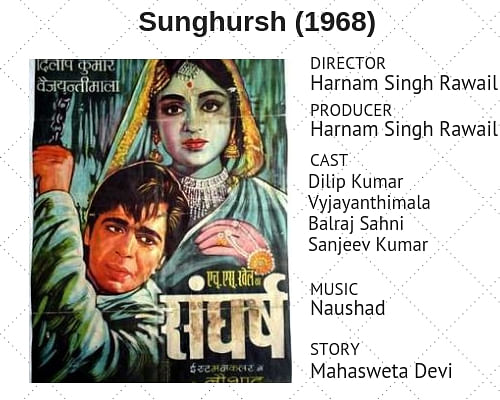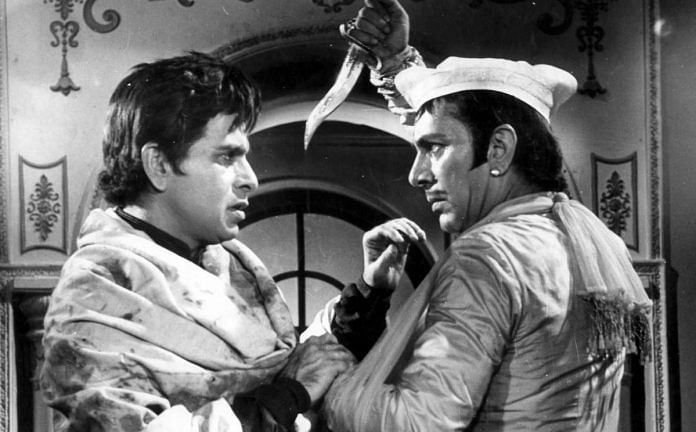If you are expecting a bandit-genre movie, Harnam Singh Rawail’s ‘Sunghursh’ is not it.
The word ‘Thug’ has re-entered popular lexicon recently, courtesy superstars Aamir Khan and Amitabh Bachchan who are set to wage a Kranti redux of sorts on Diwali in their next action-adventure, Thugs of Hindostan. Five decades ago, another superstar took on the part of a thug in director Harnam Singh Rawail’s rather successful venture, Sunghursh (1968). That was Dilip Kumar.
 Based on a short story by Mahasweta Devi, Sunghursh is a story of virtue and sin set against the backdrop of the thuggee culture in mid-19thcentury Benaras.
Based on a short story by Mahasweta Devi, Sunghursh is a story of virtue and sin set against the backdrop of the thuggee culture in mid-19thcentury Benaras.
Right from the first Eastmancolor frame of the ghats of Benaras (all visibly 20th century), Rawail reveals his intentions. This is not an ordinary tale, this is a spiritual experience. The protagonist is named Kundan (Dilip Kumar), and if Hindi cinema history is any proof, a name like that signals he is up for challenging times.
Bhavani Prasad (Jayant) is a thuggee from Benaras who is a Kali devotee and feels no compunction in killing anyone. But if you are expecting a bandit-genre movie, this is not it. This is a movie about life and its questions. In fact, there are hardly any action scenes.
Also read: Baharen Phir Bhi Aayengi was a 1966 film, but it speaks to the crisis in journalism today
Bhavani’s central quest is to find the right heir to pass on his thuggee mantle to. But his own principled son Shankar (played by Iftekhar) refuses to be a part of this sinful cult and says the thuggee culture is not the way to express devotion to Kali.
Bhavani then turns to grandson Kundan, and wants him to be his ‘Janasheen’. Google this word. It keeps popping up so many times in the movie that you need to understand what it means. Google will tell you that it means a ‘successor’, but Bhavani repeats it enough times that you will get it anyway. He is so cruel and single-minded in his quest that he separates Kundan from his mother to enlist him in the cult.
His desperation for his ‘Janasheen’ is such that he even kills his son Shankar for not following his footsteps and trying to take away his future ‘Janasheen’, the young Kundan. This was Rawail’s Hitchcock moment. No, not because of scene mechanics but casting. Rawail managed to do what no other filmmaker could. For every single police inspector role the industry threw Iftekhar’s way, Rawail gave him a one-scene role of a priest, in a white robe.
Also read: Ankhen, India’s first big spy film had a Doctor, Madam, Captain, and of course, Lily
But the plot doesn’t really kick in for long. Rawail takes too long to set things up. There are young kids who behave like adults, old people who behave like kids. That’s a lot of setting up.
But what’s the plot really about? Vendetta.
Bhavani kills Shankar but pins it on someone else. When someone threatens to expose him, Bhavani kills him too. As any self-respecting Hindi film would have, the other guy (D.K. Sapru as Naubatlal) has two young kids of his who obviously swear revenge.
And the two sons are, wait for it, Ganeshi (Balraj Sahni) and Dwarka (Sanjeev Kumar). They grow up with the sole agenda of killing Bhavani and his ‘Janasheen’ Kundan. They bring in Laila (Vyjayanthimala) to lure Kundan, who has so far stayed away from Bhavani’s business. Little do the brothers know that this is a Hindi film, and obviously Laila is not Laila but Munni, Kundan’s childhood sweetheart. She is also, by the way, a courtesan for Nawab Wajid Ali Shah.
As an aside, it merits mention that for a film set in Benaras and Calcutta during Wajid Ali Shah’s reign, not a single British officer is to be seen anywhere. Vijay Krishna Acharya is probably making up for this with his ‘East India Company’ army in Thugs of Hindostan.
Munni’s entry, and subsequently Bhavani’s departure causes his ‘Janasheen’ to reflect on the nature of life, particularly that agonising human failing – sin. He decides to make amends on behalf of his ancestry but in the process, Dwarka dies.
Three-fourths of the film is over and Balraj Sahni has barely had a scene. And then he gets one too many.
By the end, Kundan manages to apologise to Ganeshi. None is offered to the audience, though.
Also read: Sahib Bibi Aur Ghulam took on adultery way before Supreme Court did
In a film like this, music can be the only redeeming respite. This one had the combination of Naushad and Shakeel Badayuni, the team responsible for soundtracks like Mughal-e-Azam (1960). What do they have on offer here? Save for the memorable ‘Mere Pairon Mein Ghungroo’, Dilip Kumar dance, it’s difficult to recall any other track.
The actors do whatever they can do – get the pitch of the film. And they manage it well. Except it’s a pitch not worth managing. Kumar was too great an actor to ever be unwatchable. Vyjayanthimala too brought her trademark smile to it. Sanjeev Kumar delivered a great many performances in his career, probably as repentance for this one. And why Balraj Sahni? Was he so bored at home and looking for any reason to get out and trek to studios everyday? (All of the performances were lauded on release back then, and that is quite difficult to understand.)
Studios were where this Benaras-set film was shot entirely. Unremarkable, dull sets filling in for a city known for its sights. Films in those days didn’t shoot on location, but Rawail’s style is jaded.
In the backdrop of the ruinous thuggee culture, Rawail perhaps had a profound meditative thought to present: The cycle of life and legacy. His filmmaking, however, struggled to put it across. Rawail’s own ‘Janasheen’ — Rahul Rawail of ‘Arjun’ and ‘Dakait’ fame, later turned out to be far better at the job.




Just read Mirror of the Darkest Night the English Translation of Mahasweta devi’s Laayle-e Aasmaaneer Aayna on which the movie is based. It is definitely not a short story as the writer states ( unfortunately that is what Wikipedia says) but nearly 300 pages long. It was a good film with a gripping story line though totally different from the book which revolves on the character of Vyjayantimala. The book ofcourse is in a different class altogether and needs to be read just to understand how versatile and brilliant Mahasweta Devi was! The translation is done by Shyama Dasgupta Devi’s nephew.
It was a great film with stellar cast. Background score was good. Some of the scenes were too intense and great. I always loved this film and it’s concept.
Without of this article did not even attempted to understand the concept. He seems to be more interested in fault finding.
I’m disappointed with the quality of article.